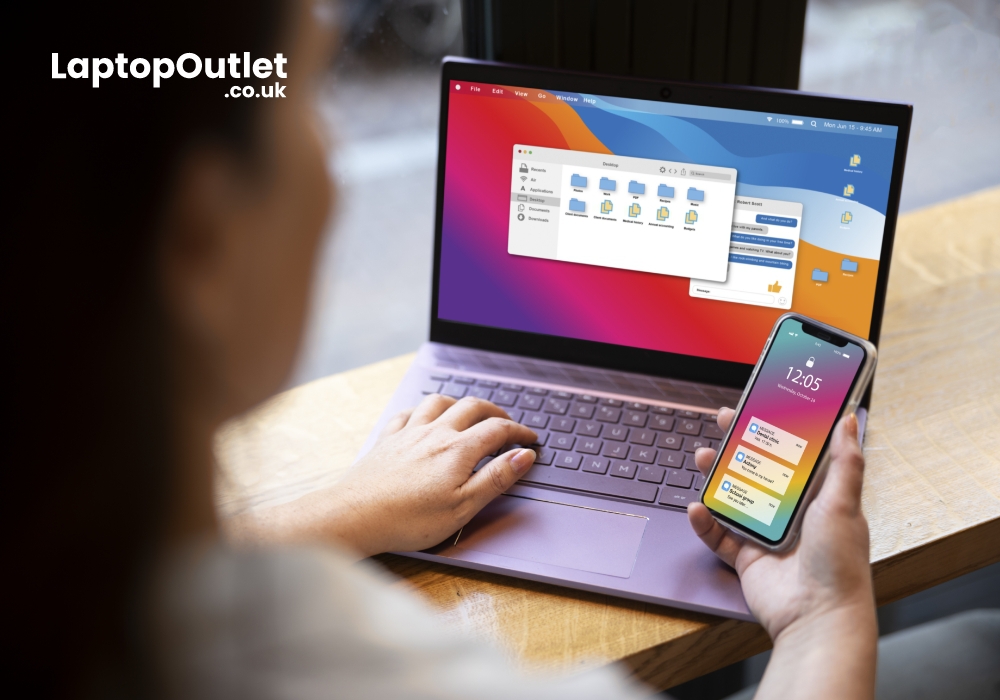The Impact of Augmented Reality on Mobile and Laptop User Interfaces

The world of technology is continuously evolving, and augmented reality (AR) is one of the most recent trends in this industry. Augmented reality refers to the technology that allows users to interface simultaneously with both real and virtual objects. AR has made significant advancements in recent years to improve the user interface of mobile devices and laptops. This blog will examine the impact of augmented reality on the user interfaces of mobile devices and laptops. Moreover, we will have an idea of how augmented reality has impacted the gaming sector and improvements in the tech industry.
Introduction to Augmented Reality
Augmented reality has been a popular topic in software development circles for a number of years, but with the release of products like Google Glass, it is gaining renewed focus and attention. Augmented reality is a technology that uses computer vision-based recognition algorithms to superimpose sound, video, graphics, and other sensor-based inputs onto real-world objects using your device's camera. It is an effective method for rendering real-world data and presenting it interactively, so that virtual elements become a part of the real world.
Virtual Reality v/s Augmented Reality
Virtual reality (VR) is frequently confused with augmented reality (AR). Virtual reality replaces the entire real environment with an artificial one, whereas augmented reality is applied to the direct view of an existing real environment and adds elements such as sounds, videos, and graphics to it.
The evolution of mobile and laptop user interfaces
The user interfaces of mobile and laptop devices have undergone significant changes over the past few decades. Early interfaces were frequently text-based, requiring users to memorise intricate commands in order to operate these devices. As technology has advanced, user interfaces have become more intuitive, user-friendly, and graphical.
With the advent of touch screens, mobile interfaces have become more intuitive and interactive. Users can now interact with their devices by scrolling and tapping. The introduction of graphical interfaces has made laptops more user-friendly and accessible to a greater number of people.
Despite these enhancements, the user interface of mobile and laptop devices remained constrained. Users were required to interact with the digital elements of these devices in a 2D space, making natural interaction with digital objects difficult. Here, augmented reality comes into play.
The use of augmented reality on mobile devices
The augmentation of the user interface is one of the most significant effects of augmented reality on mobile devices. AR enables users to interact with digital elements in a more natural and intuitive manner. For instance, numerous mobile applications now incorporate augmented reality (AR) technology to enable users to virtually try on clothes, visualise how furniture would appear in their home, and even visualise how a new car would look in their driveway.
AR has made significant advancements in the gaming industry as well. Users of mobile augmented reality games can engage in an immersive gaming experience that combines real and virtual elements. This has provided game developers with new opportunities to create engaging and interactive games that take advantage of the user's environment.
Another significant effect of augmented reality on mobile user interfaces is how it has altered our interaction with information. AR enables users to access information in a more immersive and engaging manner. Using AR technology, some mobile applications now provide users with real-time translations of foreign language signs and menus. This makes it simpler for users to navigate unfamiliar locations and interact with foreign cultures.
Augmented reality on laptops
Although augmented reality has traditionally been associated with mobile devices, it is also making significant progress on laptops. One of the most significant effects of augmented reality on laptops is the increase in user productivity. AR enables users to access information and tools in a more intuitive and engaging manner. Some laptop applications use AR technology to provide users with 3D modelling and visualisation tools in real-time.
AR has also created new opportunities for laptop-based collaboration. AR enables users to interact with digital objects in a shared virtual space, making collaboration more natural and intuitive. This proves particularly beneficial in fields like architecture and engineering, where collaboration and visualisation are essential.
AR has a significant effect on the user interfaces of laptops by enhancing the user's entertainment experience. AR enables immersive and interactive entertainment experiences, such as viewing films and playing video games. By superimposing digital elements on the actual world, augmented reality technology can create a more engaging and interactive experience for the user.
How can augmented reality improve the user interface?
Enhancing the user experience (UX) is one of the most effective methods to boost app engagement, conversions, and customer retention. To improve the user experience, developers have to focus on multiple areas. There are multiple ways in which augmented reality can improve the user experience.
AR offers multiple sources of information
Augmented reality can combine various types of data and present them in a manner that is practical and simple to comprehend. To add value to the user experience with such an attribute, however, the information must be relevant and contextualised. To better illustrate this instance, let's discuss tourism.
Imagine an app that enables users to scan their surroundings and instantly view pertinent digital information superimposed on the real world. Consider navigation instructions, cultural text prompts, opening times, business evaluations, public transport schedules, and more—or less, based on the user's settings preferences.
AR facilitates communication and teamwork
No longer is physical presence an absolute requirement for rich, instantaneous visual communication. Yes, we've come a long way since the days of smoke signals, and fortunately, people all over the world can now take advantage of sophisticated video-conferencing capabilities across great distances. However, things are still evolving for the better. Whether for business, everyday sharing, or precise remote assistance, augmented reality is revolutionising communication and collaboration.
Using augmented reality, users can now communicate with the additional ability to manipulate augmented content and add annotations (draw, highlight, place arrows, share text bubbles, etc.) that appear and remain in place on top of real-world objects during a live video stream, directly in the user's field of view. This AR-enabled feature adds a great deal of convenience, security, usability, and effectiveness to the overall user communication experience.
AR makes immersive engagement possible for consumers
In this era of rapid technological advancement, it is difficult to genuinely capture one's attention. And, as the average attention span decreases, it is unlikely to become any simpler in the near future. Due to this, mobile developers have sought innovation and found success with augmented reality. When presented with an AR experience, users tend to maintain concentration and delve deeply into the task at hand due to its inherent immersion.
Whether the augmented reality (AR) app is designed for a student learning a new language, a child playing with a toy, or a chef seeking for the ideal ingredients to cook, AR enables users to effortlessly engage and feel more connected to the product and the overall experience.
AR makes experiences entertaining
To make their mobile applications stand out as true crowd-pleasers, mobile developers must give their applications an additional edge. In this respect, Pokémon Go and Snapchat are undeniably popular worldwide. However, much more is being investigated in the domain of augmented reality entertainment.
Using augmented reality, a Michelin-starred restaurant and bar in London has created concoctions that come to life to delight their customers. A seamless augmented reality series titled "Art through the Ages" that ranges from Michelangelo to Banksy is projected around a customer's glass when they scan their drink. Enjoyable, simple to share, and an excellent conversation starter.
AR makes purchasing more enjoyable
Online purchasing has become a common practice for many individuals. In certain circumstances, however, nothing surpasses viewing the actual product in its intended environment, except for augmented reality. Users can now experience a product that is digitally and proportionally set in their physical surroundings, thanks to augmented reality. This augmented reality feature assists users in making the best decision when planning a purchase, sparing them both time and money. This valuable user experience can be better comprehended through space planning and design displays.
The Roomle 3-D furniture catalogue enables users to visualise any brand product through augmented reality using the camera on a smart device. Users can position and configure the product according to personal preference for a realistic augmented reality view after selecting a piece; this is a wonderful feature for customers and professional sales staff.
Advanced Gaming with Augmented Reality
Every year, new technologies, such as augmented reality (AR) in gaming, are introduced to the gaming industry. You cannot simply disregard the application of gamification to e-learning curricula. But what about the PC, console, and mobile titles themselves? AR technologies have numerous applications in the gaming industry, spanning from enhancing the player experience to developing new gameplay mechanics.
It is not surprising that AR technologies continue to find novel ways to revolutionise the gaming industry. AR technology has tremendous application potential in the gaming industry. The market also exhibits a significant preference for mobile gaming. According to a Newzoo report, mobile gaming will generate £70.99 billion in 2021. This remarkable figure indicates that this market segment generates more revenue than the film and music industries combined.
Why does the scale of the mobile gaming industry matter so much? According to a study by ResearchandMarkets, the application of augmented reality is being driven by the increasing popularity of mobile apps. Due to the current gaming industry's emphasis on mobile games, augmented reality holds a unique position in the industry. The expansion of the mobile gaming market presents an ideal opportunity for the widespread adoption of augmented reality (AR) technologies.
Augmented reality and technological advancements
Technology advancements have paved the way for the world to adopt augmented reality, which has considerably enhanced the user experience on a variety of devices. With the advent of potent processors, high-quality cameras, and sensors, augmented reality has never been more accessible or realistic. The ability to combine virtual and actual elements has created new opportunities for productivity, entertainment, and communication. If you're in search of mobile phones or laptops capable of supporting augmented reality programs and games, Laptop Outlet is your ultimate destination.
It is true that the increasing popularity of AR technology has led to a greater emphasis on devising intuitive and simple user interfaces. Now, developers are designing interfaces that leverage the unique capabilities of augmented reality, enabling users to interact with digital elements in a natural and intuitive manner. As augmented reality continues to become more mainstream and integrated into our daily lives, this has significant implications for the future of user interface design.
The evolution of augmented reality has also led to the emergence of new industries, such as augmented reality gaming and marketing. As technology continues to advance, we can anticipate an increase in the number of industries employing augmented reality to enhance user experiences and promote innovation. Ultimately, the advances in technology and the shift towards augmented reality carry significant implications for our interactions with digital elements. This evolution holds substantial potential to reshape our future ways of working, gaming, and communicating.
Conclusion
In conclusion, augmented reality has had a significant impact on mobile and laptop user interfaces. AR has transformed the manner in which we interact with digital elements, resulting in more intuitive, natural, and immersive experiences. AR enables users to gain access to information, tools, and entertainment in a more engaging and interactive manner, which has significant productivity, collaboration, and entertainment benefits.
As augmented reality (AR) technology continues to advance, we can anticipate even greater effects on the user interfaces of mobile and laptop devices. AR's applications range from enhancing the user's purchasing experience to enhancing the way we collaborate. It is a thrilling time to be a part of the technological world, and we cannot wait to see what the future brings.
Read more tech innovations:
| The Movember Men’s Health Charity Movement with Laptop Outlet and Intel |
| What Is AI in a Computer? The Future of Powered PCs |
| How Mobile Games and Handheld Gaming PCs Are Changing the Landscape |
Related Articles

May 06, 2025
Don’t Panic—There’s Hope
Few things are more frustrating than pressing your laptop’s power button and seeing nothing happen. If your laptop won’t turn on, it could be a simple fix—or at least something you can easily diagnose. Let’s walk through the most common reasons and solutions.
1. Check the Power Source and Cable
- Make sure the power cable is securely plugged in
- Try a different power socket
- Inspect the power adapter and charging cable for damage
- Look for lights on the laptop or charger
If possible, test with a different charger that’s compatible with your laptop
2. Perform a Hard Reset
Sometimes a simple reset can revive a laptop stuck in sleep or hibernation.
Steps:
- Unplug the laptop and remove the battery (if possible)
- Press and hold the power button for 15–30 seconds
- Reconnect the power and try turning it on again
This clears any electrical build-up in the motherboard
3. Check the Battery Health
- If your battery is removable, try turning the laptop on with

May 09, 2025
Find the Right Laptop for You
With so many laptops out there, choosing the right one can feel overwhelming. Whether you’re a student, gamer, remote worker, or creative professional, we’ve made it easy. Here’s how to decide what laptop you should buy in 2025.
1. What Will You Use Your Laptop For?
Start by identifying your main needs:
- Work/Business
- Gaming
- Study or School
- Everyday browsing and streaming
- Creative work (video editing, design, etc.)
Your use case determines the specs you’ll need
2. Best Laptops for Students
Look for portability, battery life, and value:
- Acer Swift 3 – Lightweight, great battery, affordable
- Microsoft Surface Laptop Go 3 – Stylish, compact, ideal for notes and browsing
- HP Pavilion x360 – Versatile 2-in-1, perfect for study and entertainment
3. Best Laptops for Business and Work
You’ll need performance, reliability, and security:
- Dell XPS 13 – Premium build, long battery, ideal for productivity
- Lenovo ThinkPad X1 Carbon Gen 11

May 12, 2025
Student Life Needs Smart Tech
Whether you're writing essays, attending virtual lectures, or creating presentations, having the right laptop can make or break your academic life. So, what’s the best laptop for students in 2025? We’ve handpicked the top models that balance performance, battery life, and value.
What Students Should Look for in a Laptop
- Long battery life (at least 8–10 hours)
- Lightweight and portable design
- Reliable performance for multitasking
- Good keyboard and webcam for assignments and video calls
- Affordable price to match student budgets
Best Overall Student Laptop: Apple MacBook Air M2
- Battery Life: Up to 18 hours
- Display: 13.6" Retina, great for reading and writing
- Performance: M2 chip delivers smooth multitasking
- Why Students Love It: Fast, quiet, premium build, and perfect for all student needs
Great for uni students, creative work, and note-taking
3. Best Budget Laptop for Students: Lenovo IdeaPad 3
- Battery Life: 9 hours
- Display: 15.6"

May 19, 2025
Power Meets Intelligence
Artificial Intelligence isn’t just a buzzword—it’s a growing career path and essential in modern tech workflows. Whether you’re studying data science, training ML models, or running AI software like TensorFlow or PyTorch, here’s how to choose the best laptop for AI in 2025.
What Makes a Laptop Ideal for AI Work?
To handle AI workloads effectively, your laptop should have:
- High-performance CPU (Intel Core i7/i9, AMD Ryzen 7/9)
- Powerful GPU (NVIDIA RTX or Apple M-series)
- Minimum 16GB RAM (32GB+ preferred for deep learning)
- Fast SSD storage (512GB or more)
- Support for CUDA (for NVIDIA GPU users)
A good display and thermals are also key for long sessions
Best Windows Laptop for AI: Dell XPS 15 (2025)
- CPU: Intel Core i9 (14th Gen)
- GPU: NVIDIA RTX 4070
- RAM: 32GB
- Storage: 1TB SSD
- Why It’s Great: Excellent all-rounder with AI-ready performance and stunning display
Best Mac for AI & Data Science: MacBook Pro M3 Max (2025)
- CPU/GPU: Apple

May 19, 2025
One Device, Two Ways to Work
You’ve probably seen them in stores or online—laptops that fold, flip, or detach. So, what is a 2-in-1 laptop, and why is it growing in popularity? In short, it's a laptop that doubles as a tablet, offering both flexibility and power in a single device.
What Is a 2-in-1 Laptop?
A 2-in-1 laptop is a portable device that combines the features of a traditional laptop with a touchscreen tablet. You can use it with a keyboard or switch to tablet mode for touchscreen use.
Types of 2-in-1 Laptops
- Convertible (360° hinge): Keyboard folds all the way back (e.g. HP Pavilion x360, Lenovo Yoga)
- Detachable: Keyboard detaches completely (e.g. Microsoft Surface Pro)
Convertible models are more stable for typing, while detachable ones are lighter in tablet mode
Key Features of 2-in-1 Laptops
- Touchscreen display with stylus support on some models
- Lightweight and slim design
- Flexible usage modes: Laptop, tablet, tent, and stand
- Long battery life for all-day
